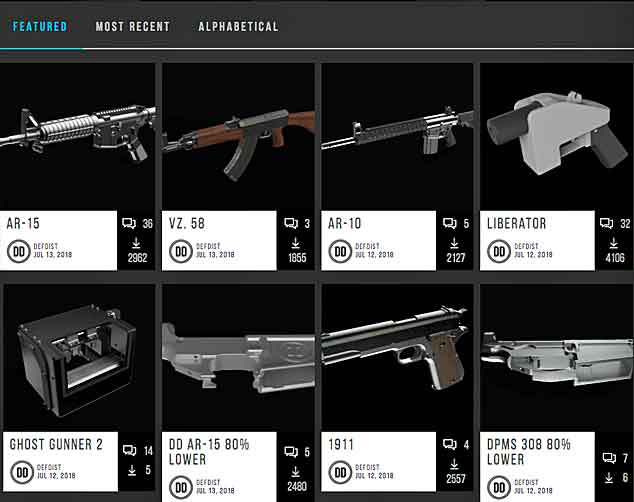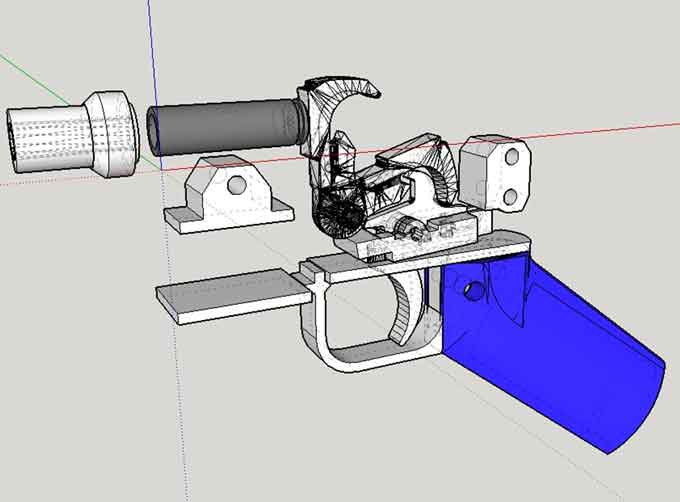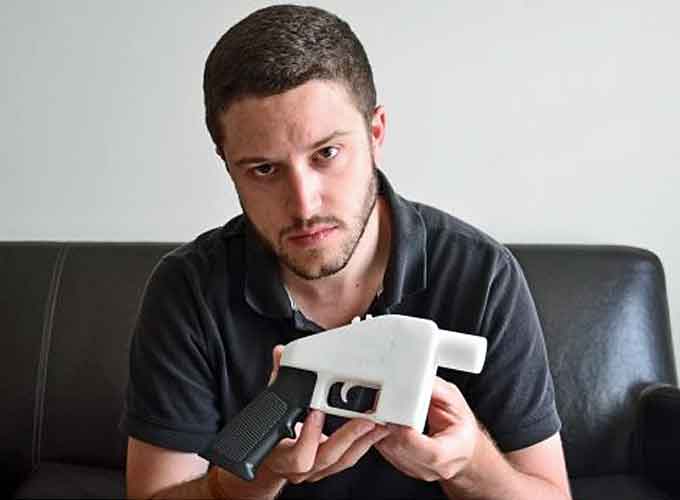
By Susannah Cullinane, CNN
Not long ago it was the stuff of science fiction, but now US officials and lawmakers are grappling with a new reality — the ability for citizens to print firearms at home.
As of Wednesday, it will be legal to download instructions on how to make a plastic handgun with a 3D printer.
The instructions for the Liberator are being published on a website run by nonprofit Defense Distributed.
So what’s the controversy all about?
(Learn More. Defense Distributed, the anarchist gun group known for its 3D printed and milled “ghost guns,” has settled a case with the federal government allowing it to upload technical data on nearly any commercially available firearm. Courtesy of WIRED and YouTube. Posted on Jul 10, 2018.)
What are 3D-printed guns?
The process of 3D printing uses computer-created digital models to create real-world objects — everything from simple chess pieces to more complex objects such as functioning clocks.
The printers follow the shape of the model by stacking layer upon layer of material to make the objects.
Do-it-yourself firearms such as the Liberator have been nicknamed “ghost guns” because they don’t have serial numbers and are untraceable.
On the Defense Distributed website, people will be able to download plans for building the Liberator as well as files for an AR-15 lower receiver, a complete Beretta M9 handgun and other firearms.
Users also will be able to share their own designs for guns, magazines and other accessories.
The high-end 3D printers needed to make such weapons cost thousands of dollars and may be too expensive for most people.
But that doesn’t ease the concerns of those who think guns made from 3D printers are a really bad idea.
What sparked the controversy?
Why did the US government intervene?
A few days after Defense Distributed posted its instructions for making a gun, the US State Department sent a three-page cease-and-desist letter to Wilson demanding that the group remove them from its website.
It accused Wilson of potentially breaching International Traffic in Arms Regulations, which regulate the export of defense materials, services and technical data.
In essence, officials said someone in another country that the United States doesn’t sell weapons to could download the material and make guns.
Wilson complied but said the files already had been downloaded 1 million times. He sued the federal government in 2015, citing his right to free speech.
(Learn More. “It doesn’t matter what the origins of the Second Amendment were,” says Cody Wilson, creator of the first 3D-printed gun and author of the new book, ‘Come and Take It: The Gun Printer’s Guide to Thinking Free.’ “With the internet, we can transform this thing into right to resistance on a global scale. If it’s just a fact that the government serves guns now, this is just a point of political life.” Courtesy of ReasonTV and YouTube. Posted on Nov 23, 2016.)
Defense Distributed reached a settlement with the US government last month that allowed it to post 3D-printable gun plans online starting August 1, 2018.
The settlement says Wilson and Defense Distributed can publish plans, files and 3D drawings in any form and exempts them from the export restrictions.
The government also agreed to pay almost $40,000 of Wilson’s legal fees and to refund some registration fees.

A State Department spokesman told CNN the settlement came after a national security analysis that determined “certain firearms and related items that are widely available for commercial sale, and technical data related to those items, is of a type that does not offer a critical military or intelligence advantage to the United States.”
The spokesman added that the US government is currently reviewing plans to transfer oversight of firearm exports from the State Department to the Commerce Department, which would eliminate the International Traffic in Arms Regulations requirements that had initially prevented the uploading of the gun production plans.
What other legal challenges are in play?
On Friday, the State Department posted a notice temporarily modifying the US Munitions List to exclude the “technical data” at the center of the lawsuit, paving the way for its legal publication.
Gun control groups lost an emergency bid the same day to block Defense Distributed from posting its instructions online.
The move to try and intervene in the case by three leading gun organizations — the Brady Campaign to Prevent Gun Violence, Everytown for Gun Safety and Giffords, a group founded by former US Rep. Gabby Giffords — was a last-ditch attempt to thwart Defense Distributed ahead of the expected online release.
In a filing, a federal judge in Texas faulted the groups for failing to prove they were actually legitimate parties to the case.
State attorneys general have been fighting to keep 3D-printed guns out.
At an emergency hearing held over the phone Sunday, Pennsylvania Attorney General Josh Shapiro asked a judge for a restraining order that would block Defense Distributed’s website from being accessible in his state.
At the hearing, Defense Distributed agreed to block Pennsylvania IP addresses for a few days until a more formal hearing could be held.
(Learn More. Soon people will be able to manufacture their own guns and gun parts with a 3-D printer, and some gun control advocates are describing this as a threat to the nation. Courtesy of CNN and YouTube. Posted on Jul 29, 2018.)
What about lawmakers?
In December 2013, a federal law requiring that all guns be detectable by metal screening machines was extended for another 10 years.
The law prohibits guns that don’t contain enough metal to trigger screening machines commonly found in airports, courthouses and other secure areas accessible to the public.
Plastic gun designs got around this restriction by containing a metal block that could be removed and that the firearm could function without.
I am looking into 3-D Plastic Guns being sold to the public. Already spoke to NRA, doesn’t seem to make much sense!
— Donald J. Trump (@realDonaldTrump) July 31, 2018
In June, Sen. Bill Nelson, D-Florida, introduced a bill in the Senate that would amend the Undetectable Firearms Act to prohibit firearms that do not have a major component that can be detected at airport security screening.
On Wednesday, Nelson tweeted, “The administration’s decision to allow people to post blueprints online about how to make a deadly 3D printed gun at home is inexplicable — and it’s dangerous!
I’m filing a bill ASAP to severely restrict the publication of these detailed plans on how to make a 3D printed firearm.”
The administration’s decision to allow people to post blueprints online about how to make a deadly 3D printed gun at home is inexplicable – and it’s dangerous! I’m filing a bill ASAP to severely restrict the publication of these detailed plans on how to make a 3D printed firearm. pic.twitter.com/ogRLcHLJPO
— Senator Bill Nelson (@SenBillNelson) July 25, 2018
On Monday, Sen. Chuck Schumer, D-New York also took to Twitter to comment on the issue, “We’re just days away from dangerous ghost gun blueprints being shared freely online & the admin has taken NO ACTION to protect our communities.
Proud to join @SenBlumenthal & @SenBillNelson in unveiling the Untraceable Firearms Act. This bill must pass before it’s too late.”
We’re just days away from dangerous ghost gun blueprints being shared freely online & the admin has taken NO ACTION to protect our communities. Proud to join @SenBlumenthal & @SenBillNelson in unveiling the Untraceable Firearms Act. This bill must pass before it’s too late.
— Chuck Schumer (@SenSchumer) July 30, 2018
What are the arguments against the guns?
Critics fear the DIY guns could easily fall into the wrong hands and create safety concerns because they’d be invisible to metal detectors.
Top prosecutors in New York and Los Angeles blasted the settlement as an “unconscionable mistake.”
“No one is safer if criminals can print untraceable guns on demand,” Los Angeles City Attorney Mike Feuer and Manhattan District Attorney Cyrus Vance Jr., co-chairs of the Prosecutors Against Gun Violence group, said in a statement.

“Allowing this exemption from federal rules would be an unconscionable mistake, making it all-too-easy for anyone with a dangerous history — including terrorists and domestic abusers who cannot pass a background check — to download files and print a functional gun with 3D printers available to any consumer.”
“This decision undermines the critical public safety laws that prosecutors enforce day in and day out,” the statement said.
Guns from 3D printers will make it easier for terrorists and people who are too dangerous to pass criminal background checks to get their hands on guns, said Avery Gardiner, co-president of the Brady Campaign to Prevent Gun Violence.
Actor and activist Alyssa Milano wrote that the settlement meant “felons, domestic abusers, terrorists, those adjudicated too mentally ill to own guns and any other person unable to legally purchase firearms will be able to print one at home.”
“It is not hyperbole to say that this could mean the end of our ability to have meaningful gun violence prevention in America,” Milano said in an opinion piece for CNN published Monday.
(The actress was involved in Georgia Congressional hopeful Jon Ossoff’s campaign. Today she’s at an anti-NRA rally in Dallas. Courtesy of Atlanta Journal-Constitution and YouTube. Posted on May 5, 2018.)
(Opposing view. Controversy regarding Alyssa Milano’s Armed Security at Anti-Gun Protest. Courtesy of NRA TV and YouTube. Posted on May 7, 2018.)
How effective are the guns?
In 2013, the Bureau of Alcohol, Tobacco, Firearms and Explosives made public tests it has done on the Liberator.
One gun made using a plastic called ABS-M30 fired a .380-caliber round without failing all eight times when it was tested, ATF officials said, describing it as “a lethal weapon.”
Another pistol made from a plastic called VisiJet didn’t perform as well, with video showing it exploding into a dozen plastic shards when fired.
In Britain, researchers at Warwick University were involved with police ballistic testing of the weapons in 2014.

The university said, “The results of the tests have shown that due to the variability in printers, software and materials the results of printing such items are highly unpredictable with the implication that if someone were to produce items the result could be complete failure and injury to the user.”
German-based 3D printing magazine All3dp said police testing showed a gun from a 3D printer “could endanger the shooter as much as anyone else.”
“A firearm produced with ABS material could break apart or even potentially explode in the hands of the user when fired.
Softer PLA will likely cause the parts to bend or deform after firing,” it said, referring to a flexible 3D printing material.
So why bother fighting to make them legal?
It’s about the right to bear arms, its advocates say.
On Monday, Defense Distributed founder Wilson tweeted, “I am now being sued by at least 21 state attorneys general.
If you want your Second Amendment online, THIS is the fight.”
I am now being sued by at least 21 state attorneys general. If you want your Second Amendment online, THIS is the fight. Join me: https://t.co/vEBBktsKS6
— Cody R. Wilson (@Radomysisky) July 30, 2018
Wilson has made no secret of his disdain for the US government in particular and all governments in general.
(Defense Distributed makes and sells components with names such as the Cuomo and the Pelosi to tweak politicians such New York’s governor and the House minority leader who support gun control efforts.)
“For me, it’s important as a symbolic political statement,” Wilson told CNN in 2013.
“And that statement is something like, ‘No, the future we imagine is one of personalized manufacture and access to objects. … In this future, people will be able to make guns for themselves.’
“That was already true, but now it’s been demonstrated in yet another technology.”
For Wilson and his supporters, the ability to build unregulated and untraceable guns will make it much harder, if not impossible, for governments to ban them.
(Learn More. CNN Justice correspondent Evan Perez reports on growing fears over 3-D printed guns. Courtesy of CNN and YouTube. Posted on Nov 14, 2013.)
What about the rest of the world?
When Defense Distributed first made the plans available in 2013, Forbes quoted one of the group’s developers as saying they had been downloaded in countries, including Spain, Brazil, Germany and the UK.
Britain’s Mail on Sunday newspaper later reported that two of its reporters had taken a Liberator gun on the Eurostar train from London to France.
(Learn More. How does the U.S. compare to the rest of the world when it comes to gun violence? Courtesy of CNN and YouTube. Posted on Oct 2, 2015.)
Britain has strict gun laws that include certification for gun owners and their weapons.
The UK’s Home Office has made it clear that “the expression ‘firearm’ in the 1968 (Firearms) Act means a lethal barrelled weapon of any description, or component part of such weapon, from which any shot, bullet or other missile can be discharged,” including 3D weapons.
A 2014 analysis of the EU Directive on Firearms prepared for the European Commission said: “As for 3D printing, in EU countries the manufacture of firearms and components with this new technology is not an issue as in the USA, since all firearms’ manufacturing is subject to government permission.”
“Furthermore, it is much easier to illegally manufacture parts of weapons by means of traditional machines which are in free circulation, cheaper and much more precise. …”
Meanwhile, an Australian briefing paper on 3D printing and crime prepared by researchers at the Queensland University of Technology said: “In some jurisdictions, it may be easier to obtain a traditional firearm (either legally or illegally) than self-produce a 3D printed gun.”
“It may be challenging for users without technical expertise to actually use 3D printers, especially cheap plastic printers.”
“However, it could be easier to buy a 3D printer and print a firearm in countries that have strict guns laws or are geographically isolated (for example, Australia).”
Original post https://www.cnn.com/2018/07/31/us/3d-printed-plastic-guns/index.html
Learn More…
(CNN’s Laurie Segall explains what 3-D printing is and why it matters. Courtesy of CNN and YouTube. Posted on May 6, 2013.)


















